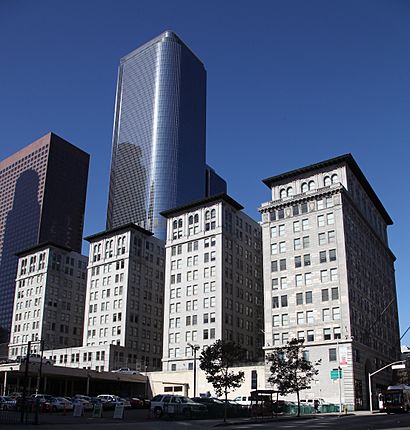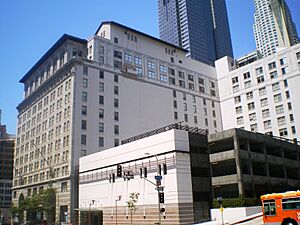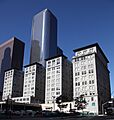Subway Terminal Building facts for kids
Quick facts for kids
Subway Terminal Building
|
|||||||||||||||||||||||||||||||||||||||||||||||||||
|---|---|---|---|---|---|---|---|---|---|---|---|---|---|---|---|---|---|---|---|---|---|---|---|---|---|---|---|---|---|---|---|---|---|---|---|---|---|---|---|---|---|---|---|---|---|---|---|---|---|---|---|

Subway Terminal Building, 2008
|
|||||||||||||||||||||||||||||||||||||||||||||||||||
| Location | 417, 415, 425 S. Hill St., 416, 420 424 S. Olive St Los Angeles, California |
||||||||||||||||||||||||||||||||||||||||||||||||||
| Coordinates | 34°03′00″N 118°15′03″W / 34.0498689°N 118.2509694°W | ||||||||||||||||||||||||||||||||||||||||||||||||||
| Tracks | 5 (subway) | ||||||||||||||||||||||||||||||||||||||||||||||||||
| History | |||||||||||||||||||||||||||||||||||||||||||||||||||
| Opened | 1925 | ||||||||||||||||||||||||||||||||||||||||||||||||||
| Closed | 1955 | ||||||||||||||||||||||||||||||||||||||||||||||||||
|
|||||||||||||||||||||||||||||||||||||||||||||||||||
|
Subway Terminal Building
|
|||||||||||||||||||||||||||||||||||||||||||||||||||
| Architectural style | Italian Renaissance Revival | ||||||||||||||||||||||||||||||||||||||||||||||||||
| NRHP reference No. | 06000657 | ||||||||||||||||||||||||||||||||||||||||||||||||||
| Significant dates | |||||||||||||||||||||||||||||||||||||||||||||||||||
| Added to NRHP | August 2, 2006 | ||||||||||||||||||||||||||||||||||||||||||||||||||
The historic Subway Terminal, now called Metro 417, opened in 1925. It was located at 417 South Hill Street in Los Angeles. This building was the second main train station for the Pacific Electric Railway. It helped passengers travel to the west and north parts of Southern California.
Trains used a special mile-long shortcut under Bunker Hill. This shortcut was called the Belmont Tunnel. Today, this tunnel is a popular place for filming movies! The Subway Terminal building was designed in an Italian Renaissance Revival style. The train station itself was underground, with offices on the floors above. These offices have since been turned into fancy apartments.
At its busiest, the Subway Terminal served over 20 million passengers each year. When the new underground Red Line was built, the Pershing Square station was placed right next to the old terminal.
Contents
History of the Subway Terminal
Building a New Station
As more cars filled the streets of downtown Los Angeles, the Pacific Electric Railway needed a better way to get trains into the city. Their first main station, the Main Street Station, shared the busy streets with cars. This caused a lot of traffic jams.
To fix this, the California Railroad Commission asked the Pacific Electric to build a special tunnel. This tunnel would let electric trains avoid the crowded downtown streets. Plans for this new station, sometimes called the "Hollywood Subway," started in 1924. Building began in May of that same year.
After 18 months of hard work and a lot of money, the Subway Terminal opened on December 1, 1925.
A Busy Hub
The Belmont Tunnel went under Bunker and Crown hills. It led from the station to the Toluca Electric Substation and Yard. This tunnel helped trains reach many areas like Hollywood, Santa Monica, Glendale, and Burbank. It made journeys much shorter, saving about 7 miles compared to other routes.
Thirty-one feet below Hill Street, the Subway Terminal had six train platforms. There was also a tower where engineers got their schedules. Electric cables above powered the trains. The station was built with unfinished concrete and cool art deco lights.
Above the platforms was a waiting room with terra cotta tiles. It even had a soda fountain and a newspaper stand. On the ground floor, the main lobbies were very grand. They had marble floors and columns, and even skylights!
The Subway Terminal was very successful. It became one of the busiest stations in Southern California from the 1920s to the 1950s. It was faster than cars and cost only 6 cents a ride! During World War II, even more people rode the trains. In 1944, about 65,000 passengers used the Subway Terminal every day. That's more than 20 million people a year!
The End of Electric Trains
After World War II, things changed. The company that owned Pacific Electric Railway sold it. Trains were slowly replaced by buses. The Pacific Electric railway system finally shut down in 1955.
The very last electric train left the Belmont Tunnel on June 19, 1955. It even had a sign that said "To Oblivion" (meaning "to forgetfulness"). Soon after, the train tracks were removed. The Subway Terminal was closed, and the tunnel was abandoned.
Becoming an Office Building
The upper floors of the Subway Terminal stayed open as an office building for many years. The tunnel below remained mostly untouched. In 1967, part of the tunnel was filled in. Later, in 1974, a large support for the Bonaventure Hotel was built through the tunnel. You could even see the tunnel from the hotel's parking garage!
When the Metro Red Line subway was built, the new Pershing Square station was placed next to the old train station. The two stations are shaped like a 'T' and are separated by a wall.
Metro 417 Apartments
In 2007, the Subway Terminal Building was renovated and renamed "Metro 417." It became a luxury apartment building. The developers cleaned the outside of the building, removing layers of paint to show the original stone. They also restored the grand lobbies with marble and brass.
The ramps that led passengers down to the underground train station were removed. The old station area itself is now sealed off. It is separated from the Red Line's Pershing Square Station by a single wall.
In 2020, a new outdoor path with tables and chairs was built next to Metro 417. This helped keep the historical feel of the building.
Main Entry Details
If you visit the building, you can still see the words "SUBWAY TERMINAL" on the floor tiles in the entryway.
Images for kids








